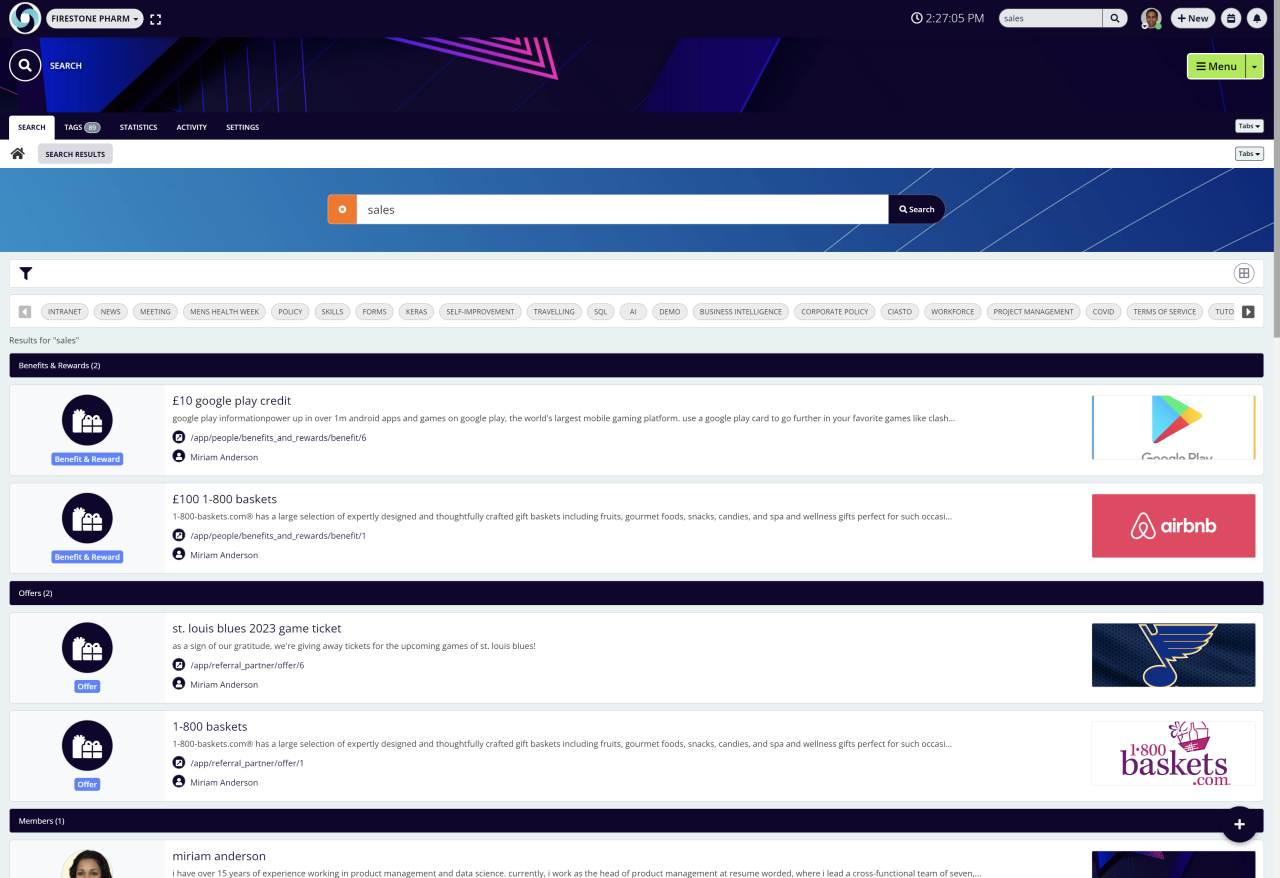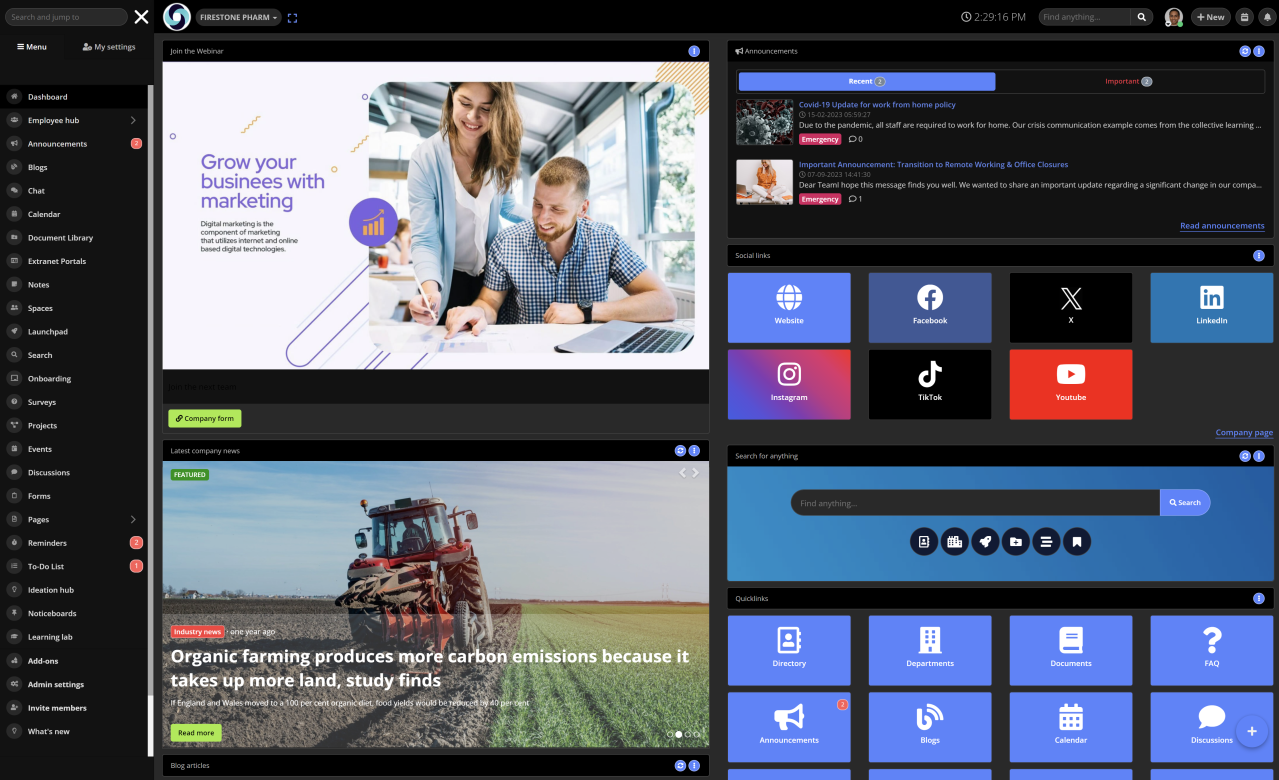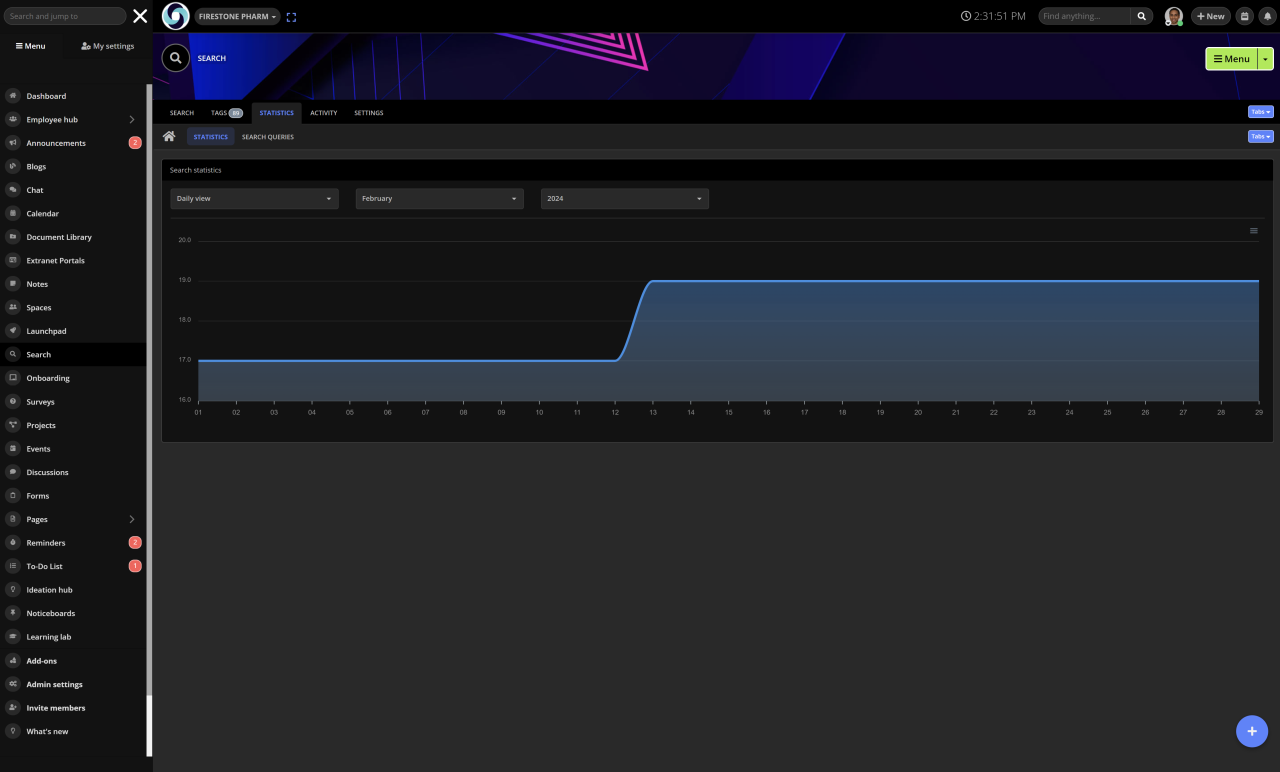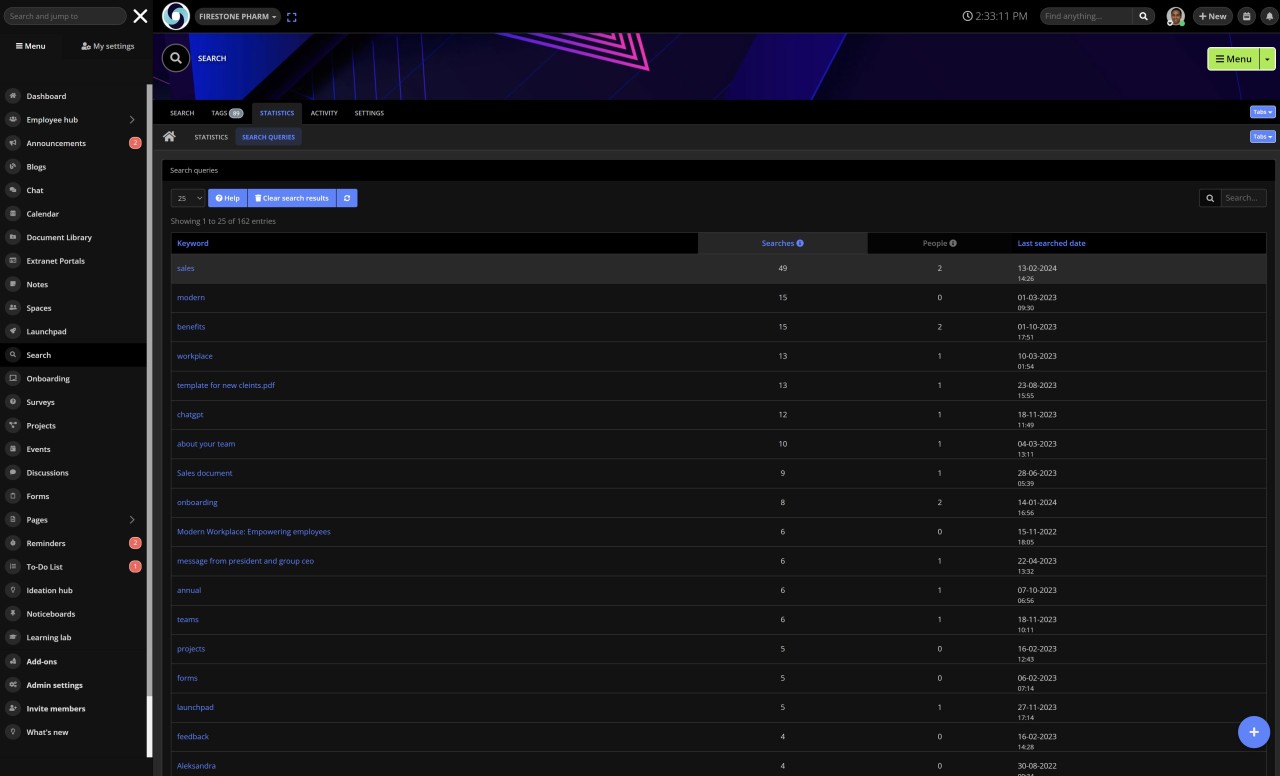Insight Blog
Agility’s perspectives on transforming the employee's experience throughout remote transformation using connected enterprise tools.
18 minutes reading time
(3669 words)
Intranet Search Engines: Everything You Need To Know in 2025
Find out the benefits of an intranet search engine for optimizing information retrieval and collaboration within organizations.
In the contemporary landscape of work, effective collaboration and communication technologies have become indispensable. Traditional methods like yelling across the office or desk visits for information retrieval are no longer feasible, particularly in remote or hybrid work settings.
A comprehensive study by McKinsey revealed a significant challenge: employees spend approximately 1.8 hours per day, translating to 9.3 hours per week, searching for information. This substantial time investment often leads to inefficiencies, equivalent to an entire workday lost.
For remote and hybrid work environments, the phrase "if it's not recorded, it didn't happen" encapsulates the struggle in managing enterprise communication and knowledge sharing online. An innovative solution to this challenge is provided by AgilityPortal, an intuitive intranet search engine.
The AgilityPortal intranet search engine plays a pivotal role within organizational intranets by empowering employees to swiftly locate pertinent information and resources.
Functioning akin to internet search engines, the intranet search engine is customized to index and retrieve data specific to the organization's internal network. It traverses documents, files, emails, databases, and other intranet-stored content, presenting users with a centralized platform for information access.
The significance of intranet search engines in contemporary workplaces cannot be overstated. As digital information within organizations grows exponentially, employees grapple with the challenge of navigating through vast content repositories.
AgilityPortal's intranet search engine addresses this issue, offering a user-friendly interface and robust search algorithms for quick and precise information retrieval.
By optimizing accessibility and knowledge-sharing across departments, intranet search engines, particularly the one provided by AgilityPortal, play a pivotal role in elevating productivity, fostering collaboration, and enhancing decision-making within organizations.
Read more on : Unlocking the Full Potential of Your Intranet Uses:13 Essential Uses for Maximizing a Modern Intranet
What is a Search Engine For Intranet?
An intranet search engine serves as the backbone for a company's information storage, access, and sharing capabilities, ensuring timely and efficient communication across all employees.
Essentially, it acts as a digital repository containing essential information and documents crucial to the company's operations.
Think of it as the Google search engine tailored specifically for your company's internal data. Unlike searching the public domain of the World Wide Web, an intranet search engine operates internally, making it exclusive to the organization. This means that documents and information remain private, accessible only to individuals within the company.
However, the effectiveness of an intranet search engine goes beyond mere search functionality, yes Intranet Best Practices is a must for location important information and documents. It should prioritize surfacing the most valuable information swiftly.
In essence, it must streamline the process of accessing critical data, contributing to the overall efficiency and productivity of the organization.
Intranet Search Engines - All You Need To Know
Intranet search engines have evolved significantly over the years, transforming from basic keyword-based tools to sophisticated platforms capable of understanding user intent and context.
Initially, intranet search engines relied on simple indexing algorithms to match search queries with relevant documents within the organization's internal network.
However, advancements in technology, such as natural language processing and machine learning, have revolutionized the capabilities of intranet search engines, enabling them to deliver more accurate and personalized search results.
Key Features and Functionalities of Intranet Search Engines
Key features and functionalities of modern intranet search engines include advanced search algorithms, faceted search capabilities, real-time indexing, and intuitive user interfaces. These features empower users to quickly locate information across a variety of content types, including documents, presentations, emails, and multimedia files.
Additionally, intranet search engines often offer features such as federated search, which allows users to search across multiple data sources simultaneously, and personalized search recommendations based on user behavior and preferences.
Follow us and access great exclusive content everyday: Follow us on Google News
Benefits of Using Intranet Search Engines for Organizations
The benefits of using intranet search engines for organizations are manifold.
Firstly, intranet search engines enhance productivity by reducing the time employees spend searching for information, enabling them to focus on more value-added tasks. Moreover, intranet search engines facilitate knowledge-sharing and collaboration by making it easy for employees to access and share relevant information across departments and teams.
Additionally, intranet search engines improve decision-making by providing access to up-to-date and accurate information, enabling leaders to make informed choices quickly.
Overall, intranet search engines play a crucial role in enhancing organizational efficiency, productivity, and innovation in today's digital workplace.
Best intranet search engines features
Secure search
Ensuring the security and privacy of your company intranet is paramount, and it should adhere to the latest data privacy standards.
However, for an added layer of control and governance over information accessibility, you might consider a platform offering finer control options.
Key security features to explore include:
- Access Control: Authorize specific users to access designated data by synchronizing with your Google Groups or Azure AD account.
- Governance: Maintain a centralized and efficient administration by controlling your intranet through an intuitive admin panel.
- Secure Data Storage: Opt for secure cloud storage to leverage a highly scalable infrastructure with top-notch security protection.
- Encryption: Safeguard data during transit by encoding it, preventing unauthorized parties from accessing sensitive information.
- Anonymization: Prevent the leakage of sensitive or personal information by anonymizing search results.
- Accountability: Configure your enterprise intranet to log all searches and actions, providing a transparent accountability trail.
- Compliance: Ensure compliance with GDPR, ISO protocols, and other security policies.
- ISO 27001 Certification: Seek platforms adhering to this international standard for effective information security management.
Maintaining data protection compliance is crucial, particularly in systems like federated intranet searches that access information across various platforms.
At AgilityPortal, we prioritize security to uphold the integrity of your enterprise intranet.
Search analytics
Comprehending the intricacies of how individuals conduct searches and quantifying the time saved through intuitive intranet search technologies is crucial.
This is where search analytics comes into play, offering insights into various aspects, including:
- Unique Search Users: Track the number of individuals utilizing the intranet search engine.
- Time Spent on Opened Results: Gauge the duration users spend on the search results page.
- Success and Failure Rates: Understand the effectiveness of searches and whether users found what they needed.
- Search Terms: Identify the specific information your team is searching for.
- Analytics Filters: Categorize terms based on department or organizational unit.
- Trending Search Terms: Monitor the most popular searches at any given time.
- Average Time to Find Results: Determine the average duration it takes to locate information.
Utilizing search analytics provides a comprehensive view of intranet search behavior, allowing organizations to enhance the search experience and optimize information retrieval efficiency.
Search filters
Enabling users to apply filters based on criteria such as authors, file types, and platforms enhances their ability to swiftly navigate through extensive document repositories. This functionality empowers individuals to sift through thousands of documents in a matter of seconds, significantly streamlining the search process.
By incorporating filters, the intranet search experience becomes not only efficient but also intuitive, allowing employees to pinpoint specific information seamlessly.
In the realm of cutting-edge intranet search engines, the inclusion of robust filters plays a pivotal role. AgilityPortal, as a leading provider in the realm of employee experience solutions, recognizes the importance of enhancing search capabilities.
By integrating advanced filters, AgilityPortal's intranet search feature empowers users to refine their searches with precision, ensuring a seamless and uninterrupted workflow.
This innovative approach ensures that employees can access the exact information they need without any disruption, fostering a more efficient and productive work environment.
Search Categories
Within the confines of an intranet, a diverse array of content types coexists, including sites, pages, documents, communities, people, and processes.
This content serves various purposes, stemming from team collaboration and official documentation to knowledge-sharing conversations and personal blog posts. The multiplicity of formats and contexts poses a significant challenge when attempting to locate specific information through intranet search.
To tackle this challenge effectively, employing search categories proves to be a valuable strategy. Each category can be tailored to exclusively return content within a predefined scope, whether it be documents, news articles, or colleagues matching a specific search term.
However, an even more potent approach involves utilizing search categories to present search results based on context. For instance, this setup enables end-users to differentiate official documents from collaborative ones, documents shared within communities, or documents stored in OneDrive.
With such a configuration, searching for a corporate policy on the environment becomes a streamlined process, allowing users to readily identify the approved policy document on the subject matter. This nuanced approach to search categories enhances the precision and relevance of search results, contributing to a more efficient and user-friendly intranet experience.
Download our eBook on How to get your intranet off the ground
A Complete Guide To Search Engines For Intranets
Intranet search engines are indispensable tools for organizations seeking to streamline information retrieval and enhance collaboration among employees. When considering intranet search engines, it's essential to understand the different types available, including local and cloud-based solutions.
You may also like: Best Apps for Employees: UPDATED 2022 – A Complete Guide
Types of Intranet Search Engines: Local vs. Cloud-based
Local intranet search engines are installed and maintained on the organization's internal servers.
These solutions offer greater control over data privacy and security, as all search operations are conducted within the organization's network. However, they may require more extensive infrastructure and IT support for implementation and maintenance.
Cloud-based intranet search engines, on the other hand, are hosted and managed by third-party providers. These solutions offer scalability, flexibility, and accessibility, as users can access the search engine from any location with an internet connection.
Cloud-based intranet search engines often leverage advanced technologies such as artificial intelligence and machine learning to deliver more accurate and relevant search results.
Factors to Consider when Choosing an Intranet Search Engine
Several factors should be considered when choosing an intranet search engine.
These include the size and complexity of the organization, the volume and diversity of content to be indexed, user requirements and preferences, budget constraints, and integration capabilities with existing systems and applications.
Additionally, organizations should assess factors such as search speed, relevance, scalability, security, and support options when evaluating intranet search engine solutions.
Best Practices for Implementing and Optimizing Intranet Search Engines
Implementing and optimizing an intranet search engine requires careful planning and execution. Organizations should start by defining clear objectives and requirements for the search engine implementation, including identifying key stakeholders and establishing success criteria. It's essential to conduct thorough content audits and taxonomy development to ensure that content is appropriately categorized and tagged for optimal searchability.
Training and communication are also critical components of a successful intranet search engine implementation.
Employees should receive comprehensive training on how to use the search engine effectively, including best practices for search queries, filters, and advanced search features.
Additionally, organizations should provide ongoing support and feedback mechanisms to address user concerns and continuously improve the search experience.
Regular monitoring and optimization are essential for maintaining the performance and relevance of an intranet search engine over time. Organizations should track key performance metrics, such as search volume, click-through rates, and user satisfaction scores, and use this data to identify areas for improvement and refinement.
By following these best practices, organizations can maximize the value and impact of their intranet search engines, leading to improved productivity, collaboration, and knowledge-sharing within the organization.
Free ebook: How To Get Your Intranet Off The Ground
Best Intranet Search Engines - UPDATED 2024
In today's digital workplace, choosing the best intranet search engine is crucial for organizations looking to streamline information retrieval and enhance collaboration among employees.
As of 2024, several intranet search engines stand out for their advanced features, user-friendly interfaces, and innovative capabilities.
Latest Trends and Advancements
The latest trends and advancements in intranet search engines reflect a focus on enhancing user experience, improving relevance and accuracy of search results, and integrating with other collaboration tools.
Artificial intelligence (AI) and machine learning (ML) technologies continue to play a significant role in powering intranet search engines, enabling more personalized and contextually relevant search experiences.
Additionally, advancements in natural language processing (NLP) and semantic search techniques are making it easier for users to express their queries in natural language and receive accurate results.
Another notable trend is the convergence of intranet search engines with other collaboration tools, such as enterprise social networks and project management platforms. This integration allows users to access relevant information and resources seamlessly across different digital channels, improving efficiency and productivity.
Furthermore, the adoption of cloud-based intranet search engines is on the rise, offering organizations greater scalability, flexibility, and accessibility.
Cloud-based solutions leverage distributed computing and data processing capabilities to deliver faster and more efficient search experiences, even for organizations with large and complex datasets.
Successful Implementations of Intranet Search Engines
Many organizations have successfully implemented intranet search engines to improve knowledge management, collaboration, and productivity. Case studies showcasing these successful implementations offer insights into best practices and strategies for leveraging intranet search engines effectively.
For example, a multinational corporation implemented a cloud-based intranet search engine that seamlessly integrated with their existing enterprise systems and applications. By leveraging AI and ML technologies, the search engine analyzed user behavior and preferences to deliver personalized search results tailored to each employee's specific needs. Consequently, employees could quickly find relevant information and resources, leading to improved productivity and decision-making across the organization.
Comparison of Top Intranet Search Engines
Several top intranet search engines dominate the market, each offering unique features and capabilities. Microsoft's SharePoint Search is a leading intranet search engine, providing robust search capabilities integrated with the SharePoint collaboration platform. SharePoint Search offers features such as federated search, content recommendations, and AI-driven relevance ranking, making it a popular choice for organizations using Microsoft products.
Elastic Workplace Search is another prominent intranet search engine, offering a unified search experience across multiple data sources and applications. Leveraging AI-powered natural language processing, Elastic Workplace Search delivers relevant results from various sources, including documents, emails, and databases.
Google Cloud Search is also noteworthy, offering enterprise-grade search capabilities powered by Google's advanced AI and ML technologies. Google Cloud Search provides intuitive search experiences across G Suite applications, enabling users to find relevant information quickly and easily.
When comparing top intranet search engines, organizations should evaluate factors such as ease of implementation, integration capabilities, pricing, and ongoing support to determine the best fit for their specific needs.
Conducting pilot tests and seeking feedback from end-users can further help organizations ensure successful implementation and adoption of their chosen intranet search engine solution.
More Intranet Search Engine Examples
When exploring intranet search engine examples, organizations have a plethora of options available to suit their specific needs and requirements. Here, we delve into additional intranet search engines present in the market, highlighting their unique features, functionalities, and considerations for organizations.
Additional Intranet Search Engines Available in the Market
In addition to the well-known intranet search engines like SharePoint Search, Elastic Workplace Search, and Google Cloud Search, several other options exist in the market. One such example is Algolia, which offers a powerful intranet search solution known for its speed, scalability, and developer-friendly features.
Algolia provides real-time indexing and advanced relevance algorithms, making it ideal for organizations with large and dynamic datasets.
Another notable intranet search engine example is Swiftype, now part of the Elastic family. Swiftype offers an intuitive and customizable search experience, with features such as faceted search, autocomplete suggestions, and robust analytics capabilities.
Swiftype's cloud-based solution is designed to integrate seamlessly with various content management systems and enterprise applications, making it easy to deploy and manage.
Unique Features and Functionalities
Each intranet search engine comes with its own set of unique features and functionalities designed to address specific user needs and preferences.
For example, Algolia is known for its instant search capabilities, delivering real-time search results as users type their queries. Swiftype, on the other hand, offers powerful customization options, allowing organizations to tailor the search experience to match their branding and user interface requirements.
Another example is Coveo, which specializes in AI-powered search and relevance. Coveo's intranet search engine leverages machine learning algorithms to understand user intent and context, delivering personalized search results based on user behavior and preferences. Additionally, Coveo offers advanced analytics and insights, enabling organizations to gain valuable insights into user search patterns and content usage.
Considerations for Organizations
When evaluating intranet search engines, organizations should consider several factors to ensure they choose the right solution for their needs. Firstly, organizations should assess the scalability and performance of the intranet search engine, especially if they anticipate significant growth or fluctuations in user demand.
Additionally, considerations such as data security, compliance requirements, and integration capabilities with existing systems and applications are crucial.
Furthermore, organizations should evaluate the ease of implementation and user adoption, considering factors such as user interface design, search relevance, and customization options.
Additionally, ongoing support and maintenance are essential considerations to ensure the intranet search engine remains effective and up-to-date over time.
Open Source Intranet Search Engine
An open-source intranet search engine offers organizations flexibility, customization, and cost-effectiveness in managing their internal information retrieval needs.
Leveraging open-source solutions empowers organizations to tailor the search engine to their unique requirements while also benefiting from a collaborative development community.
One example of an open-source intranet search engine is Apache Solr, a powerful search platform built on Apache Lucene. Solr provides advanced search capabilities, including full-text search, faceted search, and geospatial search, making it suitable for organizations with complex data retrieval requirements.
Additionally, being open-source means organizations have full control over the search engine's deployment, configuration, and ongoing maintenance, ensuring alignment with their specific goals and objectives.
Challenges and Solutions in Intranet Search Engine Implementation
Common Challenges
Implementing an intranet search engine comes with its set of challenges that organizations may encounter along the way.
One common challenge is ensuring comprehensive and accurate indexing of content across various data sources and formats within the organization. Additionally, integrating the search engine seamlessly with existing systems and applications while maintaining data security and compliance can pose significant hurdles.
User adoption and training are also key challenges, as employees may struggle to adapt to new search interfaces or may not fully understand the capabilities of the intranet search engine.
Strategies to Overcome Implementation Challenges
To address these challenges, organizations can employ several strategies.
Conducting a thorough content audit and taxonomy development can ensure that all relevant content is properly indexed and categorized within the intranet search engine. Additionally, organizations should prioritize data security and compliance throughout the implementation process by implementing robust access controls and encryption measures.
User adoption can be enhanced through comprehensive training programs, user-friendly interfaces, and ongoing support and feedback mechanisms to address any user concerns or challenges.
Tips for Ongoing Maintenance and Improvement
Once the intranet search engine is implemented, organizations must focus on ongoing maintenance and improvement to ensure its effectiveness and relevance over time. Regular monitoring of search performance metrics, such as search volume, click-through rates, and user satisfaction scores, can provide valuable insights into areas for improvement.
Organizations should also prioritize regular updates and upgrades to the search engine software to incorporate new features, enhancements, and security patches. Additionally, soliciting feedback from users and conducting periodic usability testing can help identify usability issues and inform future improvements to the intranet search engine interface and functionality.
By adopting these strategies and tips, organizations can overcome implementation challenges and ensure the long-term success of their intranet search engine initiatives.
Wrapping up, choosing a Intranet with a powerful Search Engine
Choosing the right intranet software with a powerful search demands a trustworthy technology partner with a proven track record in delivering effective intranet solutions tailored for nonprofits.
At AgilityPortal, we bring over 5 years of experience in the intranet business, having successfully implemented intranets across diverse sectors, including finance, education, law firms, healthcare, and nonprofits.
Our intranet software specifically designed for charities and nonprofit organizations establishes a collaborative space that seamlessly connects every stakeholder, from part-time volunteers to the chief executive and trustees. Using our intuitive drag-and-drop CMS, you have the flexibility to craft a personalized charity intranet.
We provide over 50 configurable intranet widgets, empowering you to design your intranet homepage, departmental pages, and team sites with ease.
The intranet news application ensures effective communication within the charity, enabling targeted updates for staff and stakeholders. This feature allows you to tailor content to specific teams or individuals, ensuring they only receive information relevant to their roles. Additionally, our intranet software is adaptable to any language, allowing menus, system messages, and content to be displayed in the preferred language of the end user.
To explore how AgilityPortal can seamlessly meet the unique requirements of your nonprofit organization, including providing an effective intranet solution, book a demo with our experts.
Wrapping up
Intranet search engines are indispensable tools for organizations seeking to streamline information retrieval, enhance collaboration, and drive productivity.
Despite implementation challenges, such as content indexing and user adoption, organizations can overcome these hurdles through careful planning, robust strategies, and ongoing maintenance.
By leveraging the latest trends, advancements, and best practices, organizations can maximize the value and impact of their intranet search engine initiatives, ultimately empowering employees to access and utilize information effectively.
Categories
Blog
(2620)
Business Management
(320)
Employee Engagement
(210)
Digital Transformation
(175)
Growth
(119)
Intranets
(119)
Remote Work
(61)
Sales
(48)
Collaboration
(37)
Culture
(29)
Project management
(29)
Customer Experience
(26)
Knowledge Management
(21)
Leadership
(20)
Comparisons
(6)
News
(1)
Ready to learn more? 👍
One platform to optimize, manage and track all of your teams. Your new digital workplace is a click away. 🚀
Free for 14 days, no credit card required.


















